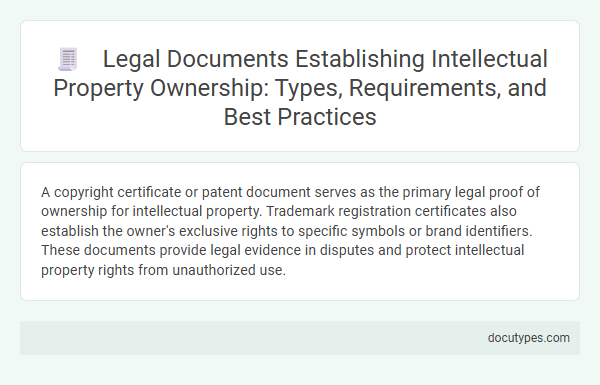A copyright certificate or patent document serves as the primary legal proof of ownership for intellectual property. Trademark registration certificates also establish the owner's exclusive rights to specific symbols or brand identifiers. These documents provide legal evidence in disputes and protect intellectual property rights from unauthorized use.
Introduction to Legal Documents for Intellectual Property Ownership
Proving ownership of intellectual property requires specific legal documents that establish your rights. These documents serve as official evidence to protect and enforce your intellectual property assets.
- Patent Certificate - A legal document issued by a patent office that grants exclusive rights to an invention.
- Trademark Registration - Official proof of ownership for trademarks, protecting brand names and logos.
- Copyright Certificate - Documentation that verifies rights over original creative works like literature, music, and art.
Types of Legal Documents Establishing IP Ownership
What legal document is used to prove ownership of intellectual property? Intellectual property ownership is typically established through specific legal documents that serve as official proof. Common types include patents, copyrights, trademarks, and assignment agreements.
Assignment Agreements: Transferring Intellectual Property Rights
Assignment agreements are the primary legal documents used to prove ownership of intellectual property by formally transferring rights from one party to another. These agreements clearly outline the scope of the transfer, ensuring that the new owner has full legal control over the intellectual property.
By executing an assignment agreement, you establish a legally binding record that your intellectual property rights have been transferred, eliminating any ambiguity about ownership. The document typically includes details such as the parties involved, specific intellectual property being assigned, and terms of the transfer. Properly drafted assignment agreements protect both the assignor and assignee by preventing future disputes over intellectual property ownership.
Licensing Agreements: Permitting Use of Intellectual Property
Licensing agreements serve as essential legal documents that permit the use of intellectual property while maintaining ownership rights. These agreements explicitly define the scope, duration, and conditions under which intellectual property can be used by another party.
By outlining terms for royalties, usage limits, and exclusivity, licensing agreements protect your rights and ensure proper compensation. Such documents act as proof of permission, clarifying the legal relationship between the owner and licensee regarding intellectual property.
Confidentiality and Non-Disclosure Agreements
Confidentiality and Non-Disclosure Agreements (NDAs) are essential legal documents used to protect intellectual property ownership. These agreements establish the terms under which sensitive information is shared and prevent unauthorized use or disclosure.
- Confidentiality Agreement - A contract that legally binds parties to keep proprietary information private.
- Non-Disclosure Agreement (NDA) - A specific type of confidentiality agreement focused on restricting the sharing of intellectual property details.
- Ownership Proof - NDAs help demonstrate control over intellectual property by documenting who has access and under what conditions.
These agreements play a crucial role in safeguarding intellectual property rights and proving ownership in legal contexts.
Requirements for Valid Intellectual Property Documentation
The legal document used to prove ownership of intellectual property is a registered certificate issued by the relevant intellectual property office, such as a patent certificate, trademark registration, or copyright certificate. These documents serve as official proof of your rights to the specific intellectual property asset.
Requirements for valid intellectual property documentation include clear identification of the owner, detailed descriptions of the intellectual property, and proper filing with the authorized government agency. Accurate and timely submission of these documents ensures your legal protection and enforcement of ownership rights.
Registration Procedures for Patents, Trademarks, and Copyrights
Legal ownership of intellectual property is typically proven through official registration documents issued by authoritative government agencies. For patents, inventors must file a detailed application with the patent office, demonstrating novelty and utility, followed by examination and approval to receive a patent certificate. Trademarks require submission of a distinct mark to the trademark office, undergoing a review process before registration is granted, while copyrights automatically exist upon creation but can be registered for stronger legal protection through the copyright office's formal application procedures.
Best Practices for Drafting and Maintaining IP Ownership Documents
Legal documents such as intellectual property assignment agreements are essential to prove ownership of intellectual property rights. Maintaining clear, precise, and updated documents ensures your ownership is legally recognized and enforceable.
- Use Clear Definitions - Clearly define the intellectual property involved and specify the rights being assigned or licensed to avoid ambiguity.
- Include Detailed Ownership Clauses - Outline who owns the intellectual property at each stage to prevent future disputes over ownership or rights.
- Regularly Update Documentation - Review and amend IP ownership documents periodically to reflect any changes in ownership, licensing, or related agreements.
Common Pitfalls and Errors in IP Ownership Documentation
The primary legal document used to prove ownership of intellectual property (IP) is the IP registration certificate, which serves as official proof of rights granted by a governmental authority. Common pitfalls in IP ownership documentation include incomplete assignment agreements, unclear inventorship or authorship, and failure to record transfers with relevant IP offices. Errors such as neglecting to document joint ownership or not updating ownership after acquisitions can result in costly disputes and weakened enforcement rights.
What Legal Document Is Used to Prove Ownership of Intellectual Property? Infographic

